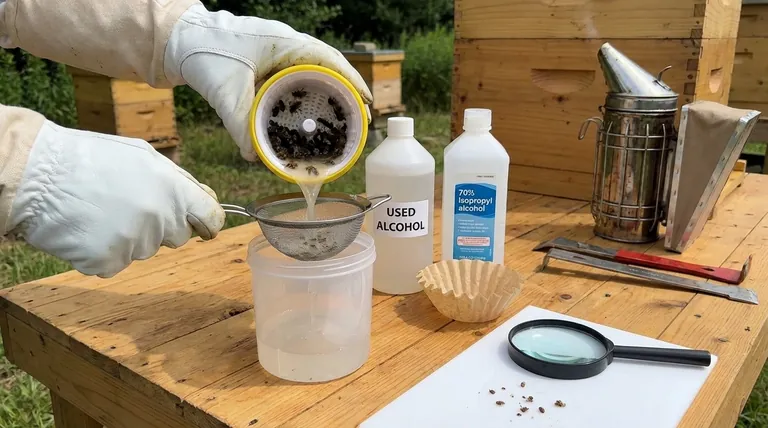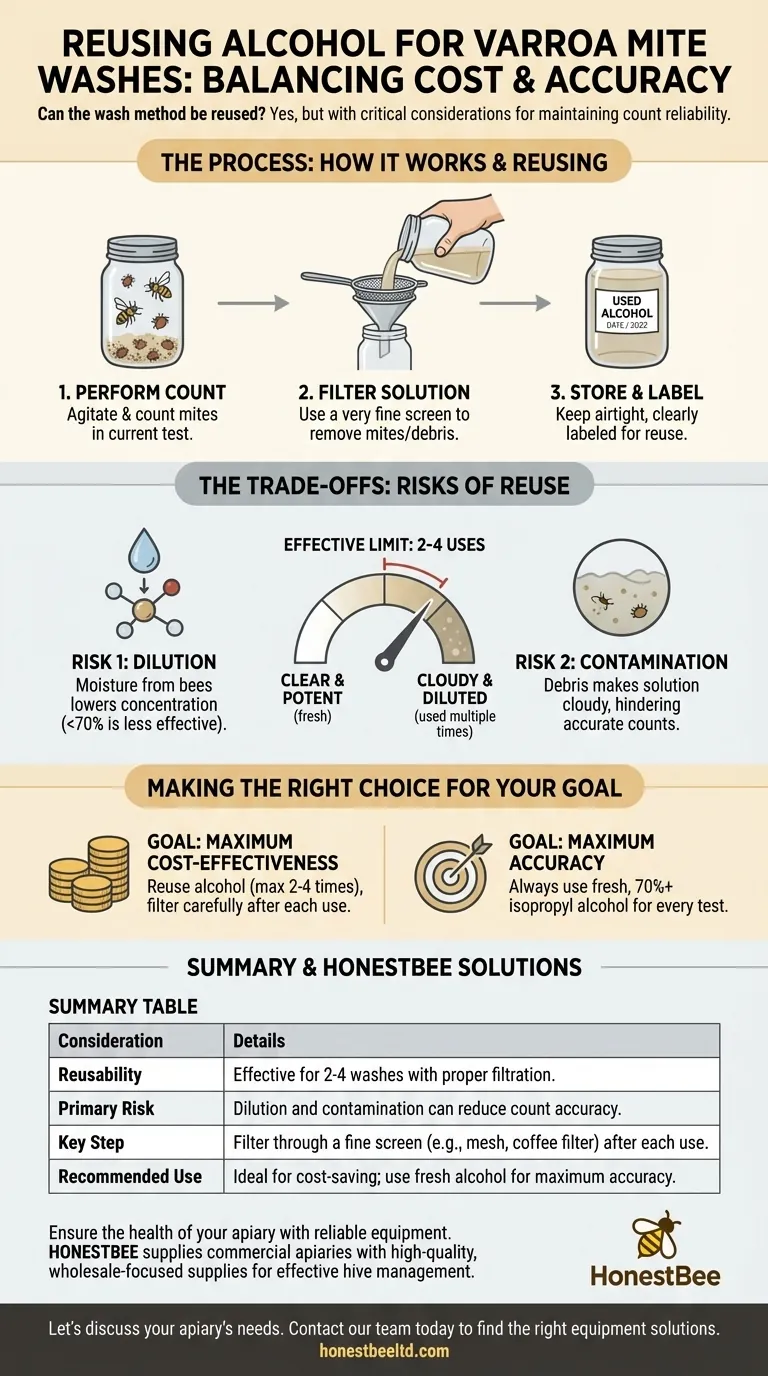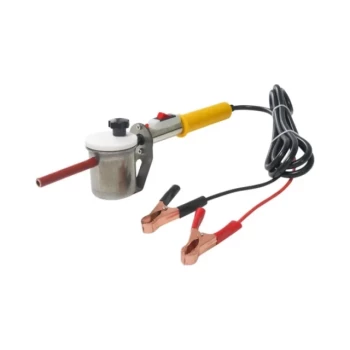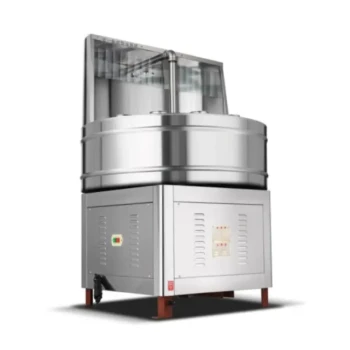Yes, you can reuse the alcohol from a varroa mite wash for multiple assessments. The process involves filtering the used solution through a very fine screen to remove the mites and any bee debris before using it for the next sample.
While reusing alcohol is an effective way to reduce costs, the primary goal is to maintain the accuracy of your mite count. This requires careful filtration and an awareness that the alcohol's concentration and clarity will degrade over time, potentially compromising future test results.

The Principle of the Alcohol Wash
Why Alcohol Works
The alcohol wash is a standard method for monitoring varroa mite levels in a honey bee colony. A sample of bees is submerged in alcohol, which quickly kills both the bees and the mites.
The agitation of the sample jar dislodges the mites from the bees' bodies, allowing them to be easily counted.
The Importance of Concentration
For the test to be effective, the solution must have a high enough alcohol concentration to quickly kill the mites and prevent them from clinging to the bees.
Isopropyl alcohol at 70% concentration or higher is the standard recommendation. Solutions with lower concentrations, like windshield washer fluid, may be less effective and are not a reliable substitute.
The Process for Reusing Alcohol
Step 1: Complete Your Mite Count
Before attempting to reuse the solution, you must first complete the current test. Agitate your sample thoroughly and count all the mites that have settled at the bottom of your testing container.
Step 2: Filter the Solution
Pour the used alcohol and bee/mite mixture through a filtration device. The goal is to separate the liquid from all solid materials.
A very fine mesh screen, a reusable coffee filter, or even a section of a standard window screen can work effectively for this purpose. You want a filter fine enough to catch mites but coarse enough to let the liquid pass through easily.
Step 3: Store and Label
Pour the filtered alcohol into a clean, airtight container. It is critical to label this container as "Used Alcohol" to avoid mixing it with your fresh supply.
Understanding the Trade-offs
The Risk of Dilution
Each time you perform a wash, you introduce moisture from the bees' bodies into the alcohol. This, combined with natural evaporation, will gradually lower the alcohol's concentration, making it less effective over time.
A diluted solution may fail to kill and dislodge mites efficiently, leading to an inaccurate, lower-than-reality mite count.
The Problem of Contamination
Even with good filtering, tiny particles of bee parts, wax, and propolis can remain suspended in the used alcohol.
This contamination makes the solution cloudy, which can make it significantly more difficult to see and accurately count mites in subsequent tests.
How Many Times Can It Be Reused?
There is no hard rule, but the solution's effectiveness visibly decreases with each use. Most beekeepers find they can reuse a batch of alcohol 2 to 4 times before it becomes too cloudy or diluted to be reliable.
Making the Right Choice for Your Goal
- If your primary focus is maximum cost-effectiveness: Reuse your alcohol, but filter it carefully after each use and discard it as soon as it becomes cloudy or after the fourth test.
- If your primary focus is maximum accuracy: Always use fresh, 70%+ isopropyl alcohol for every mite test to ensure your data is completely reliable.
Ultimately, an accurate mite count is one of the most powerful tools you have for maintaining a healthy, productive colony.
Summary Table:
| Consideration | Details |
|---|---|
| Reusability | Effective for 2-4 washes with proper filtration. |
| Primary Risk | Dilution and contamination can reduce count accuracy. |
| Key Step | Filter through a fine screen (e.g., mesh, coffee filter) after each use. |
| Recommended Use | Ideal for cost-saving; use fresh alcohol for maximum accuracy. |
Ensure the health of your apiary with reliable equipment from HONESTBEE.
Accurate varroa mite testing is crucial for protecting your investment. HONESTBEE supplies commercial apiaries and beekeeping equipment distributors with the high-quality, wholesale-focused supplies needed for effective hive management—from testing jars to durable protective gear.
Let's discuss your apiary's needs. Contact our team today to find the right equipment solutions for your operation.
Visual Guide

Related Products
- Varroa Easy Check Mite Tester Kit Counter Alcohol Wash Jar
- 12V Bee Mite Removal Evaporator Oxalic Acid Vaporizer for Bee Fumigation Treatment 180W Atomization
- Heavy Duty 12V Oxalic Acid Evaporator Vaporizer for Bee Varroa Mite Treatment Beekeeping Fumigator Atomizer
- HONESTBEE 24 Head Rotary Bottle Washing Machine
- Wooden Queen Bee Excluder for Beekeeping
People Also Ask
- What is the most accurate method for monitoring varroa mites? The Definitive Guide for Beekeepers
- Why is an alcohol wash preferred over powdered sugar rolls? For Accurate Varroa Mite Management
- What is the Varroa EasyCheck and its purpose? Streamline Your Hive Health Monitoring
- How often should varroa mite checks be performed using the alcohol wash method? Optimize Your Apiary's Health
- What is the Varroa EasyCheck used for? Accurate Mite Monitoring for Healthy Hives


















